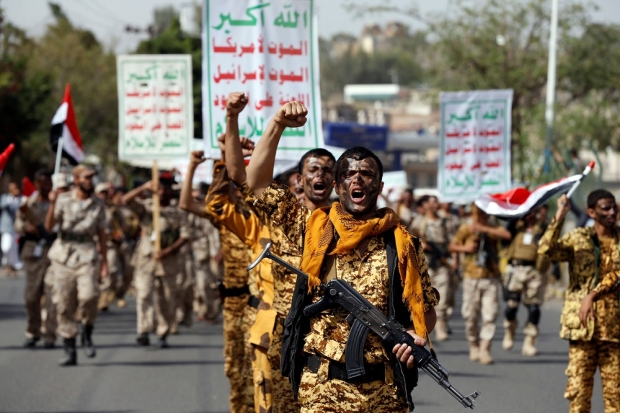Nowhere to run: Death follows Yemen's destitute war refugees

TAIZ, Yemen - Abdul Moghni sits at his house near a makeshift camp in al-Hamili that is home to hundreds of refugees, who fled their homes as fighting threatened their lives. But their flight has not found them safety.
Hamili may not be a refugee himself, but only because he cannot afford to run. He is trapped here with everyone else, in Taiz province, one of Yemen's many "conflict zones", where frontlines shift constantly as Saudi-backed forces battle Houthi rebels, engulfing the streams of refugees wherever they seek peace.
On Tuesday, in Hamili, what are believed to be Saudi bombs killed 21 people during a new offensive by pro-government forces. Many of those killed had fled fighting in Mokha.
“All the displaced people in Hamili are needy and do not have enough money to pay for transport to a safe area,” Moghni told Middle East Eye.
“It is also not easy to find land to set up new camps as people do not welcome refugees in their area.”
Panic has set in at the camp, as residents find themselves in the middle of a new battle. But they have nowhere to go. Displaced once already, their destitution and poverty means they can’t afford to go anywhere else.
This pro-government offensive in the Hamili region came with an advance warning to the displaced residents, but means little in essence.
“We warned the displaced people to leave the area but they declined to leave and insisted on staying while air strikes were targeting Houthis in the Hamili area," a member of the local Popular Resistance force told MEE.
"An air strike targeted a displaced camp by mistake and killed 21 people, including seven women."
He said the assault was launched on Tuesday and that the displaced only started relocating again after the air strike on the camp.
To add to their misery, refugees also find themselves unwelcome by their own people and deprived of support from humanitarian organisations.
The air strike on Tuesday is not the first. In May, a Saudi coalition air strike killed 17 in the same area.
Another camp for the displaced in Sanaa’s Nihm district was targeted in February. In March, the al-Marzak camp in Hajja province was targeted.
Wider effects
The latest bombing of the Hamili camp has the displaced in other nearby camps also fearing for their safety.
Mohammed Ali, in his 50s, fled the Hamili area in April and took his nine family members to a makeshift camp in al-Ma’afer area, which is less than 10km from the current conflict zone in Hamili.
They live in tents erected from plastic sheets and blankets. There are no toilets or cooking facilities. And now they have to contend with the rainy season.
But Ali admits his wife’s insistence to move here might have saved their lives.
“The war arrived to my neighbourhood in April but it was still quite far from the al-Hamili camp, which was targeted on Tuesday. I was thinking of moving to that camp but my wife refused because the war was moving towards the camp’s area so we decided to come here,” he told MEE.
Local resentment at refugee influx
Ali and his family cannot afford to go further away, but they simultaneously face the problem of not being wanted by the locals in the area.
“The people of this area hardly allowed us to set up camps and started asking us to leave. But we have nowhere else to go,” he said. “We live outdoors and in fear of the war. Moreover, we have not found merciful people to help us.”
Ali Abdul Bari, a representative of the local council of Al-Ma’afer district, told MEE that local residents were responsible for the lack of any NGO presence and assistance in the area.
“Actually there was an NGO trying to set up a camp but the local residents opposed it. They believe that the displaced are competitors when it comes to work and aid,” he said.
Meanwhile, the member of the Popular Resistance force signalled no let-up in the offensive regardless of the presence of civilians, saying mistakes happened and civilians could be affected.
“I urge the residents and displaced people in the conflict zones to flee their houses and camps. Life is the most important thing. I know they will suffer a lot but it is better than remaining in the midst of war,” he said.
Abdul Moghni reached the same conclusion and was fortunate to have found an escape.
“I was unable to find an alternative before. But in the next two days I will travel to live at a cousin’s house in the al-Hodeida district in Bagel,” he said.
Bitterness towards humanitarian organisations is also increasing among the war displaced, who say the minimum they need is shelter.
Moghni urged NGOs to provide transport and safe areas to establish camps for others who were left with no choice but to face bombs and bullets.
But Abubakr Abdu, another refugee, turned his ire on those same NGOs for their seeming inability to help anyone.
"Our urgent demand is a camp in a safe area where we are accepted. Some people now consider us invaders and not refugees from neighbouring areas," he told MEE.
“If I am killed by an air strike or by shelling, I don’t want organisations to demand an investigation into my killing. I want the world to investigate the humanitarian organisations active in Yemen and why they did not help us."
New MEE newsletter: Jerusalem Dispatch
Sign up to get the latest insights and analysis on Israel-Palestine, alongside Turkey Unpacked and other MEE newsletters
Middle East Eye delivers independent and unrivalled coverage and analysis of the Middle East, North Africa and beyond. To learn more about republishing this content and the associated fees, please fill out this form. More about MEE can be found here.






